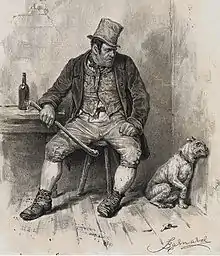Oliver Twist
Oliver Twist; or, The Parish Boy's Progress, is the second novel by English author Charles Dickens. It was originally published as a serial from 1837 to 1839, and as a three-volume book in 1838.[1] The story follows the titular orphan, who, after being raised in a workhouse, escapes to London, where he meets a gang of juvenile pickpockets led by the elderly criminal Fagin, discovers the secrets of his parentage, and reconnects with his remaining family.
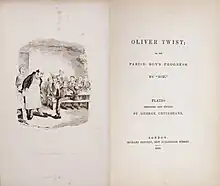 Frontispiece and title-page, first edition 1838 Illustration and design by George Cruikshank | |
| Author | Charles Dickens |
|---|---|
| Original title | Oliver Twist; or, The Parish Boy's Progress |
| Illustrator | George Cruikshank |
| Country | England |
| Language | English |
| Genre | Serial novel |
| Published | Serialised 1837–1839; book form 1838 |
| Publisher | Serial: Bentley's Miscellany Book: Richard Bentley |
| OCLC | 185812519 |
| Preceded by | The Pickwick Papers |
| Followed by | Nicholas Nickleby |
| Text | Oliver Twist at Wikisource |
Oliver Twist unromantically portrays the sordid lives of criminals, and exposes the cruel treatment of the many orphans in London in the mid-19th century.[2] The alternative title, The Parish Boy's Progress, alludes to Bunyan's The Pilgrim's Progress, as well as the 18th-century caricature series by painter William Hogarth, A Rake's Progress and A Harlot's Progress.[3]
In an early example of the social novel, Dickens satirises child labour, domestic violence, the recruitment of children as criminals, and the presence of street children. The novel may have been inspired by the story of Robert Blincoe, an orphan whose account of working as a child labourer in a cotton mill was widely read in the 1830s. It is likely that Dickens's own experiences as a youth contributed as well, considering he spent two years of his life in the workhouse at the age of 12 and subsequently, missed out on some of his education.[4]
Oliver Twist has been the subject of numerous adaptations, including a 1948 film of the same title, starring Alec Guinness as Fagin; a highly successful musical, Oliver! (itself adapted into a multiple Academy Award-winning 1968 motion picture), and Disney's 1988 animated feature film Oliver & Company.[5]
Publications
The novel was first published in monthly instalments, from February 1837 to April 1839, in the magazine Bentley's Miscellany. It was originally intended to form part of Dickens's serial, The Mudfog Papers.[6][7][8] George Cruikshank provided one steel etching per month to illustrate each instalment.[9] The novel first appeared in book form six months before the initial serialisation was completed, in three volumes published by Richard Bentley, the owner of Bentley's Miscellany, under the author's pseudonym, "Boz". It included 24 steel-engraved plates by Cruikshank.
The first edition was titled: Oliver Twist, or, The Parish Boy's Progress.
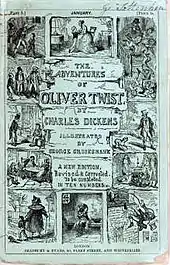
Serial publication dates:[10]
- I – February 1837 (chapters 1–2)
- II – March 1837 (chapters 3–4)
- III – April 1837 (chapters 5–6)
- IV – May 1837 (chapters 7–8)
- V – July 1837 (chapters 9–11)
- VI – August 1837 (chapters 12–13)
- VII – September 1837 (chapters 14–15)
- VIII – November 1837 (chapters 16–17)
- IX – December 1837 (chapters 18–19)
- X – January 1838 (chapters 20–22)
- XI – February 1838 (chapters 23–25)
- XII – March 1838 (chapters 26–27)
- XIII – April 1838 (chapters 28–30)
- XIV – May 1838 (chapters 31–32)
- XV – June 1838 (chapters 33–34)
- XVI – July 1838 (chapters 35–37)
- XVII – August 1838 (chapters 38–part of 39)
- XVIII – October 1838 (conclusion of chapter 39–41)
- XIX – November 1838 (chapters 42–43)
- XX – December 1838 (chapters 44–46)
- XXI – January 1839 (chapters 47–49)
- XXII – February 1839 (chapter 50)
- XXIII – March 1839 (chapter 51)
- XXIV – April 1839 (chapters 52–53)
Plot
Oliver Twist is born into a life of poverty and misfortune, raised in a workhouse in the fictional town of Mudfog. The children working there receive very little food; after six months, they draw lots, with the loser asking for another portion of gruel. Oliver is designated, and so he approaches workhouse manager Mr Bumble and humbly requests another serving. A great uproar ensues at this perceived act of rebellion.
Oliver is removed from the workhouse and sent into the service of undertaker Mr Sowerberry. One day, jealous co-apprentice Noah Claypole insults Oliver's mother and an enraged physical altercation ensues. Oliver runs away to London to seek a better life.
.jpg.webp)
Oliver meets a young man named Jack Dawkins who calls himself "the Artful Dodger", offers him food and lodging and takes him to meet an infamous criminal known as Fagin, who trains orphan boys as pickpockets. Oliver innocently begins Fagin's training, but when he goes out with the Dodger and another boy and sees them stealing a handkerchief from an old gentleman named Mr Brownlow, he realizes the truth. While the Dodger and the other boy escape, Oliver is pursued, apprehended, formally arrested and tried before Magistrate Fang. Interceding for Oliver, Brownlow takes him home and cares for him. As Oliver recovers, Brownlow and his housekeeper notice that Oliver resembles a woman depicted in a portrait hanging in Brownlow's home.
Worried that Oliver might incriminate him and his gang, Fagin sends a young woman named Nancy and her abusive lover, the robber Bill Sikes, to abduct Oliver and bring him back to Fagin's lair. Fagin forces him to participate in a burglary planned by Sikes. The robbery goes wrong; while Sikes escapes, Oliver, after having been wounded, ends up in the care of the people he was supposed to rob: Miss Rose and her guardian Mrs Maylie.

A mysterious man, known only as "Monks," teams up with Fagin, to prevent Oliver from learning of his past. Monks bribes Mr Bumble and his new wife, the former Widow Corney, for information on Oliver. Together, they dispose of a ring and medallion that had once belonged to Oliver's mother and had been stolen from her after she died. Nancy, racked with guilt for her role in Oliver's kidnapping, secretly spies on them and passes the information on to Rose Maylie, who tells Mr Brownlow. Meanwhile, the Artful Dodger is arrested for pickpocketing, tried and sentenced to Transportation to Australia.
Noah Claypole, who had fled to London with the Sowerberry's maid Charlotte after robbing Mr Sowerberry, joins Fagin's gang. Following Fagin's orders, he follows Nancy and discovers that she regularly meets with the Brownlows and Maylies for the sake of Oliver's welfare. Fearing that Nancy has betrayed him and Sikes (which, unknown to him, she has refused to do), Fagin passes the information on to Sikes, who beats Nancy to death in a fit of rage and goes into hiding. He is recognised by an angry mob and attempts to flee. Going to Fagin's hideout, he learns that Fagin has been arrested. When the mob catches up to him, he tries to escape over the rooftops by swinging on a rope, but while he is about to loop the rope about himself a vision of the dead Nancy's staring eyes terrorises him into losing his balance; in the fall, the looped rope catches him around the neck and hangs him.
.png.webp)
Mr Brownlow has Monks arrested and forces him to divulge his secrets: he is actually Oliver's half-brother and had hoped to steal Oliver's half of their rightful inheritance. Brownlow begs Oliver to give half his inheritance to Monks and grant him a second chance, to which Oliver happily agrees. Monks emigrates to America, but squanders his money, relapses into crime and dies in prison. Fagin is arrested and sentenced to the gallows. The day before his execution, Oliver and Mr Brownlow visit him in Newgate Prison and learn the location of the documents proving Oliver's identity. Bumble and his wife lose their jobs and are forced to become inmates of the workhouse. Rose Maylie, who turns out to be Oliver's maternal aunt, marries and enjoys a long life. Oliver lives happily as Mr Brownlow's adopted son.
Characters
- Oliver Twist – an orphan child whose mother died at his birth; father is dead when Oliver's paternity is revealed.
- Mr Bumble – a beadle in the parish workhouse where Oliver was born
- Mrs. Mann – superintendent where the infant Oliver is placed until age 9 who is not capable of caring for the "culprits" as she is self-centred and greedy.
- Mr Sowerberry – an undertaker who took Oliver as apprentice
- Mrs Sowerberry – Mr. Sowerberry's wife
- Noah Claypole – a cowardly bully, Sowerberry's apprentice
- Charlotte – the Sowerberrys' maid, lover of Noah
- Mr Gamfield – a chimney sweep in the town where Oliver was born
- Mr Brownlow – a kindly gentleman who takes Oliver in, his first benefactor
- Mr Grimwig – a friend of Mr. Brownlow
- Mrs Bedwin – Mr. Brownlow's housekeeper
- Rose Maylie – Oliver's second benefactor, later found to be his aunt
- Mrs Lindsay Maylie – Harry Maylie's mother. Rose Maylie's adoptive aunt
- Harry Maylie – Mrs. Maylie's son
- Mr Losberne – Mrs. Maylie's family doctor
- Mr Giles – Mrs. Maylie's butler
- Mr Brittles – Mrs. Maylie's handyman
- Duff and Blathers – two incompetent policemen
- Fagin – fence and boss of a criminal gang of young boys and girls
- Bill Sikes – a professional burglar
- Bull's Eye – Bill Sikes's vicious dog
- The Artful Dodger – Fagin's most adept pickpocket
- Charley Bates – a pickpocket in Fagin's gang
- Toby Crackit – an associate of Fagin and Sikes, a house-breaker
- Nancy – one of Fagin's gang, now living with Bill Sikes
- Bet – a girl in Fagin's gang, sometime friend to Nancy
- Barney – a criminal cohort of Fagin
- Agnes Fleming – Oliver's mother
- Mr Leeford – father of Oliver and Monks
- Old Sally – a nurse who attended Oliver's birth
- Mrs Corney – matron for the women's workhouse
- Monks – a sickly criminal, an associate of Fagin's, and long-lost half-brother of Oliver
- Monks's mother – an heiress who did not love her husband
- Mr Fang – a magistrate
- Tom Chitling – one of Fagin's gang members, returned from abroad at the time of the murder
Major themes and symbols
.jpg.webp)
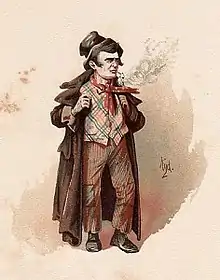
In Oliver Twist, Dickens mixes grim realism with merciless satire to describe the effects of industrialism on 19th-century England and to criticise the harsh new Poor Laws. Oliver, an innocent child, is trapped in a world where his only options seem to be the workhouse, a life of crime symbolised by Fagin's gang, a prison, or an early grave. From this unpromising industrial/institutional setting, however, a fairy tale also emerges. In the midst of corruption and degradation, the essentially passive Oliver remains pure-hearted; he steers away from evil when those around him give in to it, and in proper fairy-tale fashion, he eventually receives his reward – leaving for a peaceful life in the country, surrounded by kind friends. On the way to this happy ending, Dickens explores the kind of life an outcast, orphan boy could expect to lead in 1830s London.[11]
Poverty and social class
Poverty is a prominent concern in Oliver Twist. Throughout the novel, Dickens enlarged on this theme, describing slums so decrepit that whole rows of houses are on the point of ruin. In an early chapter, Oliver attends a pauper's funeral with Mr Sowerberry and sees a whole family crowded together in one miserable room. This prevalent misery makes Oliver's encounters with charity and love more poignant. Oliver owes his life several times over to kindness both large and small.[12]
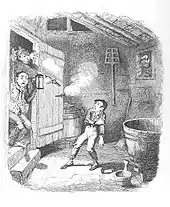
Symbolism
Dickens makes considerable use of symbolism. The "merry old gentleman" Fagin, for example, has satanic characteristics: he is a veteran corrupter of young boys who presides over his own corner of the criminal world; he makes his first appearance standing over a fire holding a toasting fork, and he refuses to pray on the night before his execution.[13]
Characters
.png.webp)
In the tradition of Restoration Comedy and Henry Fielding, Dickens fits his characters with appropriate names. Oliver himself, though "badged and ticketed" as a lowly orphan and named according to an alphabetical system, is, in fact, "all of a twist."[14] However, Oliver and his name may have been based on a young workhouse boy named Peter Tolliver whom Dickens knew while growing up.[15]
Bill Sikes's dog, Bull's-eye, has "faults of temper in common with his owner" and is an emblem of his owner's character. The dog's viciousness represents Sikes's animal-like brutality while Sikes's self-destructiveness is evident in the dog's many scars. The dog, with its willingness to harm anyone on Sikes's whim, shows the mindless brutality of the master. This is also illustrated when Sikes dies and the dog immediately dies as well.[16]
Nancy, by contrast, redeems herself at the cost of her own life and dies in a prayerful pose. She is one of the few characters in Oliver Twist to display much ambivalence. Her storyline in the novel strongly reflects themes of domestic violence and psychological abuse at the hands of Bill. Although Nancy is a full-fledged criminal, indoctrinated and trained by Fagin since childhood, she retains enough empathy to repent her role in Oliver's kidnapping, and to take steps to try to atone. As one of Fagin's victims, corrupted but not yet morally dead, she gives eloquent voice to the horrors of the old man's little criminal empire. She wants to save Oliver from a similar fate; at the same time, she recoils from the idea of turning traitor, especially to Bill Sikes, whom she loves. When Dickens was later criticised for giving to a "thieving, whoring slut of the streets" such an unaccountable reversal of character, he ascribed her change of heart to "the last fair drop of water at the bottom of a dried-up, weed-choked well".[17]
Allegations of antisemitism
Dickens has been accused of portraying antisemitic stereotypes because of his portrayal of the Jewish character Fagin in Oliver Twist. Paul Vallely writes that Fagin is widely seen as one of the most grotesque Jews in English literature, and one of the most vivid of Dickens's 989 characters.[18] Nadia Valman, in Antisemitism: A Historical Encyclopedia of Prejudice and Persecution, argues that Fagin's representation was drawn from the image of the Jew as inherently evil, that the imagery associated him with the Devil, and with beasts.[19]
The novel refers to Fagin 274 times[20] in the first 38 chapters as "the Jew", while the ethnicity or religion of the other characters is rarely mentioned.[18] In 1854, The Jewish Chronicle asked why "Jews alone should be excluded from the 'sympathizing heart' of this great author and powerful friend of the oppressed." Dickens (who had extensive knowledge of London street life and child exploitation) explained that he had made Fagin Jewish because "it unfortunately was true, of the time to which the story refers, that that class of criminal almost invariably was a Jew."[21] It is widely believed that Fagin was based on a specific Jewish criminal of the era, Ikey Solomon.[22] Dickens commented that by calling Fagin a Jew he had meant no imputation against the Jewish people, saying in a letter, "I have no feeling towards the Jews but a friendly one. I always speak well of them, whether in public or private, and bear my testimony (as I ought to do) to their perfect good faith in such transactions as I have ever had with them."[23] Eliza Davis, whose husband had purchased Dickens's home in 1860 when he had put it up for sale, wrote to Dickens in protest at his portrayal of Fagin, arguing that he had "encouraged a vile prejudice against the despised Hebrew", and that he had done a great wrong to the Jewish people. While Dickens first reacted defensively upon receiving Davis's letter, he then halted the printing of Oliver Twist, and changed the text for the parts of the book that had not been set, which explains why after the first 38 chapters Fagin is barely called "the Jew" at all in the next 179 references to him. A shift in his perspective is seen in his later novel Our Mutual Friend, as he redeems the image of Jews.[18]
Reception
Contemporary reviewers including John Forster and the Literary Gazette praised the book for its realistic depiction of social conditions. However others such as Richard Ford considered it an exaggeration of poverty.[24]
Audio recordings
Dicken's novel has been recorded many times as an audiobook. Notable recordings include:
- An audio dramatization titled The Adventures Of Oliver Twist And Fagin starring Basil Rathbone as both The Narrator and Fagin was released by Columbia Masterworks Records (MM-700) in a 3-disc 75rpm set in 1947.[25] This was later re-released by Columbia Records in 33rpm format in 1955 (CL 674) and again in 1977 (P13902).[26]
- Decca Records released an abridged recording of the novel narrated by James Mason (DL 9107) in 1962.[27]
- Anthony Quayle narrated Chapters One, Two, Eight and Nine of the novel on a Caedmon Records recording (TC 1484) released in 1976.[28]
- Paul Scofield narrated an abridged version in 1987 for Dove Audio.[29]
- An abridged version narrated by Martin Jarvis was released on audio cassette in 1994, later on CD, as part of the Talking Classics series (TC NCC 004) by Orbis.[30] Mr. Jarvis later narrated an unabridged version in 2006 for Audible Studios.[31]
- Alex Jennings narrated an abridged version in 1995 for Penguin Audiobooks.[32]
- Miriam Margolyes narrated an unabridged version in 2005 for Blackstone Audio.[33]
- Gerald Dickens, the great-great-grandson of Charles Dickens, narrated an unabridged version in 2011.[34]
- Jonathan Pryce narrated an unabridged version in 2019 for Audible Studios as part of The Audible Dickens Collection.[35]
Film, television, radio and theatrical adaptations
Film
- Oliver Twist (1909), the first adaptation of Dickens's novel, a silent film starring Edith Storey and Elita Proctor Otis.
- Oliver Twist (1912), a British silent film adaptation, directed by Thomas Bentley.
- Oliver Twist (1912), an American silent film adaptation starring Nat C. Goodwin.
- Oliver Twist (1916), a silent film adaptation, starring Marie Doro and Tully Marshall.
- Oliver Twist (1919), a silent Hungarian film adaptation.
- Oliver Twist (1922), silent film adaptation featuring Lon Chaney and Jackie Coogan.
- Oliver Twist (1933), the first sound production of Dickens's novel.
- Oliver Twist (1948), David Lean film adaptation starring Alec Guinness as Fagin.
- Manik (1961), Bengali film directed by Bijalibaran Sen which was based on this novel. The film stars Pahari Sanyal, Chhabi Biswas, Sombhu Mitra and Tripti Mitra.[36]
- Oliver! (1968), British musical adaptation, winner in the Best Picture category at the 41st Academy Awards.
- Oliver Twist (1974), an animated film co-written by Ben Starr.
- Oliver Twist (1982), an Australian animated film.
- Las Aventuras de Oliver Twist (1987), a Mexican animated film.
- Oliver & Company (1988), Disney full-length animated feature inspired by the story of Oliver Twist.[5] The story takes place in modern-day New York City, with Oliver (voiced by Joey Lawrence) portrayed as an orphaned kitten, the Dodger as a street-wise mongrel with a mix of terrier (voiced by Billy Joel), and Fagin (voiced by Dom DeLuise) as a homeless tramp who lives on the docks with his pack of stray dogs that he trains to steal so he can survive and repay his debt to loan shark Sykes (voiced by Robert Loggia).[37]
- Twisted (1996), an independent film based on Charles Dickens's novel Oliver Twist set in the gay underground sub-culture of New York City in the 1990s and starring Emmy Award, Tony Award, Grammy Award winner Billy Porter and Academy Award nominee William Hickey (actor) directed by Seth Michael Donsky.
- Oliver Twist (1997), directed by Tony Bill and starring Richard Dreyfuss and Elijah Wood.
- Twist (2003), an independent film loosely based on Charles Dickens's novel Oliver Twist
- Boy Called Twist (2004), a South African film which resets the story in modern-day Cape Town and turns Fagin into an Ethiopian Rastafarian.
- Oliver Twist (2005), directed by Roman Polanski and starring Barney Clark and Ben Kingsley.
- Twist (2021), modern day version directed by Martion Owen, and starring Michael Caine as Fagin.[38][39]
Television
- 1962: Oliver Twist, a 13-episode BBC serial directed by Eric Tayler, starring Max Adrian as Fagin, Willoughby Goddard as Mr Bumble and Peter Vaughan as Bill Sikes.[40]
- 1980: The Further Adventures of Oliver Twist, a British television series set as a sequel, with Daniel Murray as Oliver, John Fowler as The Artful Dodger and David Swift as Fagin.[41]
- 1982: Oliver Twist, a TV movie directed by Clive Donner, starring George C. Scott as Fagin and Tim Curry as Bill Sikes.
- 1985: Oliver Twist, a 12-episode BBC One drama directed by Gareth Davies, starring Eric Porter and Michael Attwell.[42]
- 1999: Oliver Twist, an ITV drama adaptation starring Andy Serkis and Keira Knightley.
- 2007: Oliver Twist, a 5-episode BBC One drama directed by Coky Giedroyc, starring Timothy Spall, Julian Rhind-Tutt, Edward Fox, Anna Massey and Tom Hardy.[43]
- 1996-97: Saban's Adventures of Oliver Twist, a 52-episode animated American-French co-production where the story is downplayed for younger viewers, in which Oliver loses his mother in a crowd rather than being dead and the characters are represented by anthropomorphic animals. Oliver in this version is a young dog.
- 2001: Escape of the Artful Dodger, an Australian TV series set as a sequel, where Dodger and Oliver are sent to the colony of Australia.
- 2020: The Animaniacs 2020 revival featured a two-part parody of the story titled "Wakkiver Twist" in season 2, featuring Yakko, Wakko, and Dot Warner playing the roles of a trio version of Oliver while Fagin is played by the Warners' usual foil, Dr. Otto von Scratchansniff.
Radio
- 1928, BBC Liverpool, with Olive Worthington (Oliver Twist), J.P. Lambe (Fagin), Walter Shore (The Artful Dodger), Mrs Fred Wilkinson (Nancy) and Philip H. Harper (Bill Sikes)[44]
- 1934, BBC Regional Programme, adapted by J. Comyns Carr, with Desmond Tester (Oliver Twist), Harcourt Williams (Fagin), Frederick Peisley (The Artful Dodger), Barbara Couper (Nancy) and Matthew Boulton (Bill Sikes)[45]
- 1941-42, BBC Home Service in 8 parts, adapted by Audrey Lucas, with David Baxter (Oliver Twist), Malcolm Keen (Fagin), Leonard Thorne (The Artful Dodger), Belle Chrystall (Nancy) and Allan Jeaves (Bill Sikes)[46]
- 1947, NBC Radio, Favorite Story, broadcast April 29th 1947, hosted by Ronald Colman with Henry Blair, Arthur Q. Bryan, Gloria Gordon, Edmund MacDonald, Peter Rankin and Virginia Gregg[47]
- 1952, BBC Home Service in 12 parts, adapted by Giles Cooper, with Wilfrid Downing (Oliver Twist), John Gabriel (Fagin), Brian Smith (The Artful Dodger), Helen Shingler (Nancy) and Ralph Truman (Bill Sikes)[48]
- 1970, BBC Radio 4 in 12 parts, adapted by Giles Cooper, with Stephen Bone (Oliver Twist), Peter Woodthorpe (Fagin), Dennis Conoley (The Artful Dodger), Patricia Leventon (Nancy) and John Hollis (Bill Sikes)[49]
- 1994, BBC Radio 4 in 6 parts, adapted and directed by Nigel Bryant, with Edward Long (Oliver Twist), John Grillo (Fagin), Richard Pearce (The Artful Dodger), Adjoa Andoh (Nancy) and Tim McInnerny (Bill Sikes)[50]
Theatre
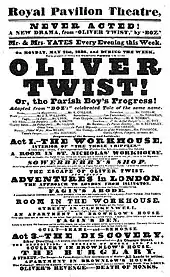
- In 1838 Charles Zachary Barnett's adaptation, the three-act burletta Oliver Twist; or, The Parish Boy's Progress opened at the Marylebone Theatre in London.[51]
- Oliver!, a 1960 West End theatre stage musical adaptation by Lionel Bart.[52] The original cast featured Ron Moody as Fagin (he would reprise the role for the film adaptation), and boys who alternated in the juvenile lead of the Artful Dodger included Phil Collins and Davy Jones.[53] Many songs are well known to the public, such as "Food, Glorious Food", "Consider Yourself" and "I'd Do Anything".[54]
- Oliver Twist is a 2017 stage adaptation of the novel written by Anya Reiss which premiered at the Regent's Park Theatre. The show was directed by Caroline Byrne.[55]
References
- "Oliver Twist | Introduction & Summary". Encyclopedia Britannica. Archived from the original on 22 August 2019. Retrieved 4 April 2018.
- Donovan, Frank. The Children of Charles Dickens. London: Leslie Frewin, 1968, pp. 61–62.
- Dunn, Richard J. Oliver Twist: Heart and Soul (Twayne's Masterwork Series No. 118). New York: Macmillan, p. 37.
- Dickens, Charles. Oliver Twist. Kiddy Monster Publication. p. Summary.
- "Oliver and Company". 1988. Archived from the original on 30 May 2019. Retrieved 13 February 2017.
- Dickens, Charles. Oliver Twist, or, The Parish Boy's Progress Edited by Philip Horne. Penguin Classics, 2003, p. 486. ISBN 0-14-143974-2.
- Ackroyd, Peter (1990). Dickens. London: Sinclair-Stevenson. p. 216. ISBN 1-85619-000-5.
- Bentley's Miscellany, 1837.
- Schlicke, Paul (Editor). Oxford Reader's Companion to Dickens. Oxford: Oxford University Press, 1999, p. 141.
- "Masterpiece Theater on PBS.org". PBS. Archived from the original on 13 August 2014. Retrieved 7 September 2017.
- Miller, J. Hillis. "The Dark World of Oliver Twist" in Charles Dickens (Harold Bloom, editor), New York: Chelsea House Publishers, 1987, p. 35
- Walder, Dennis, "Oliver Twist and Charity" in Oliver Twist: a Norton Critical Edition (Fred Kaplan, Editor). New York: W.W. Norton, 1993, pp. 515–525
- Miller, ibid, p. 48
- Ashley, Leonard. What's in a name?: Everything you wanted to know. Genealogical Publishing, 1989, p. 200.
- Richardson, Ruth. "Dickens and the Workhouse: Oliver Twist and the London Poor." Oxford University Press, USA, 2012, p. 56.
- "NovelGuide". Archived from the original on 30 March 2003. Retrieved 30 September 2012.
- Donovan, Frank, The Children of Charles Dickens, p. 79.
- Vallely, Paul (7 October 2005). "Dickens' greatest villain: The faces of Fagin". independent.co.uk. The Independent. Archived from the original on 5 December 2008. Retrieved 13 February 2015.
- Valman, Nadia (2005). "Dickens, Charles (1812–1870)". In Levy, Richard S. (ed.). Antisemitism, A Historical Encyclopedia of Prejudice and Persecution. Santa Barbara, Calif.: ABC–Clio. pp. 176–177. ISBN 1-85109-439-3. Archived from the original on 1 June 2022. Retrieved 30 December 2020.
- "The Project Gutenberg eBook of Oliver Twist, by Charles Dickens". Archived from the original on 16 July 2019. Retrieved 2 July 2019.
- Howe, Irving (31 May 2005). "Oliver Twist – introduction". Random House Publishing. ISBN 9780553901566. Archived from the original on 26 March 2022. Retrieved 26 December 2021.
- Donald Hawes, Who's Who in Dickens, Routledge, London, 2002, p.75.
- Johnson, Edgar (1 January 1952). "4 – Intimations of Mortality". Charles Dickens His Tragedy And Triumph. Simon & Schuster Inc. Archived from the original on 2 October 2011. Retrieved 8 February 2009.
- SUNY - 19th Century English https://c19.sunygeneseoenglish.org/2014/09/10/influence-of-dickens-contemporary-critics-on-social-discussion/
- "Basil Rathbone – The Adventures Of Oliver Twist And Fagin". Discogs.com. October 1947. Retrieved 18 May 2023.
- "Basil Rathbone / Errol Flynn – The Three Musketeers / Oliver Twist". Discogs.com. Retrieved 18 May 2023.
- "James Mason, Charles Dickens – Oliver Twist". Discogs.com. 16 August 1962. Retrieved 18 May 2023.
- "Anthony Quayle – Four Chapters From Oliver Twist By Charles Dickens". Discogs.com. 16 August 1976. Retrieved 18 May 2023.
- "Radio and Spoken Word 1980s-1990s - Oliver Twist". The Recorded Performances of Paul Scofield. Retrieved 19 May 2023.
- "Read By Martin Jarvis – Oliver Twist". Discogs.com. 16 August 1994. Retrieved 18 May 2023.
- Oliver Twist by Charles Dickens Narrated by: Martin Jarvis. Retrieved 18 May 2023 – via Audible.com.
- Oliver Twist by Charles Dickens Narrated by Alex Jennings. Retrieved 19 May 2023 – via Audible.com.
- Oliver Twist by Charles Dickens Narrated by Miriam Margolyes. Retrieved 18 May 2023 – via Audible.com.
- Oliver Twist by Charles Dickens Narrated by Gerald Dickens. Retrieved 18 May 2023 – via Audible.com.
- Oliver Twist by Charles Dickens Narrated by Jonathan Pryce. Retrieved 18 May 2023 – via Audible.com.
- Souvik Chatterji Master of Law from Warwick University, Coventry, UK, footnote [2] (2007). Influence of Bengali Classic Literature in Bollywood films.
{{cite book}}: CS1 maint: multiple names: authors list (link) - Howe, Desson (18 November 1988). "Oliver & Company". The Washington Post. Archived from the original on 16 October 2016. Retrieved 1 March 2018.
- "Michael Caine and Lena Headey's Modern-Day 'Oliver Twist' Sells to Saban". 25 November 2019. Archived from the original on 26 November 2019. Retrieved 26 November 2019.
- "Saban Films Acquires Charles Dickens Retelling 'Twist'". The Hollywood Reporter. 25 November 2019. Archived from the original on 26 November 2019. Retrieved 26 November 2019.
- "Oliver Twist: Episode 1". BBC Programme Index. BBC. 7 January 1962. Archived from the original on 26 March 2022. Retrieved 21 September 2021.
- "The Further Adventures of Oliver Twist". IMDB.com. Retrieved 15 March 2023.
- "Oliver Twist". BBC. 25 July 2007. Archived from the original on 1 June 2022. Retrieved 13 July 2018.
- "All-star cast announced for BBC adaptation of Oliver Twist". BBC. 13–29 October 1985. Archived from the original on 6 July 2018. Retrieved 19 July 2018.
- "6LV Liverpool - Oliver Twist". BBC Programme Index. 18 February 1928. Retrieved 18 May 2023.
- "BBC Regional Programme - Oliver Twist". BBC Programme Index. 28 December 1934. Retrieved 18 May 2023.
- "BBC Home Service - Oliver Twist". BBC Programme Index. Retrieved 18 May 2023.
- "Favorite Story - Radio Log". Jerry Haendiges Vintage Radio Logs. Retrieved 18 May 2023.
- "BBC Home Service - Oliver Twist (1952)". BBC Programme Index. Retrieved 18 May 2023.
- "BBC Radio 4 - Oliver Twist (1970)". BBC Programme Index. Retrieved 18 May 2023.
- "BBC Radio 4 - Oliver Twist (1994)". BBC Programme Index. Retrieved 18 May 2023.
- "Theatres in Victorian London - Victorian Web". Archived from the original on 17 March 2020. Retrieved 17 March 2020.
- Coveney, Michael (17 March 2017). "Oliver!: The real story of Britain's greatest musical". The Independent. Archived from the original on 18 May 2017. Retrieved 1 March 2018.
- McLean, Craig (4 September 2010). "Rock's outsider: Phil Collins interview". The Telegraph. Archived from the original on 10 January 2022. Retrieved 21 March 2022.
- "Oliver!: The real story of Britain's greatest musical". The Independent. 17 March 2017. Archived from the original on 18 May 2017. Retrieved 1 March 2018.
- Gillinson, Miriam (27 July 2017). "Oliver Twist review – artful production gets lost down blind alleys". The Guardian. ISSN 0261-3077. Archived from the original on 1 January 2020. Retrieved 1 January 2020.
External links
- Online versions
- Oliver Twist to read online at Bookwise
- Oliver Twist at Standard Ebooks
- Manuscript material and articles relating to Oliver Twist from the British Library's Discovering Literature website.
- Oliver Twist at Internet Archive
- Oliver Twist at Project Gutenberg
- Oliver Twist in PDF, epub, Kindle formats at Global Grey ebooks
 Oliver Twist public domain audiobook at LibriVox
Oliver Twist public domain audiobook at LibriVox- Oliver Twist, or, The Parish Boy's Progress Typeset PDF version, including the illustrations of James Mahoney (1871 Household Edition by Chapman & Hall).
- Critical analysis
.jpg.webp)
